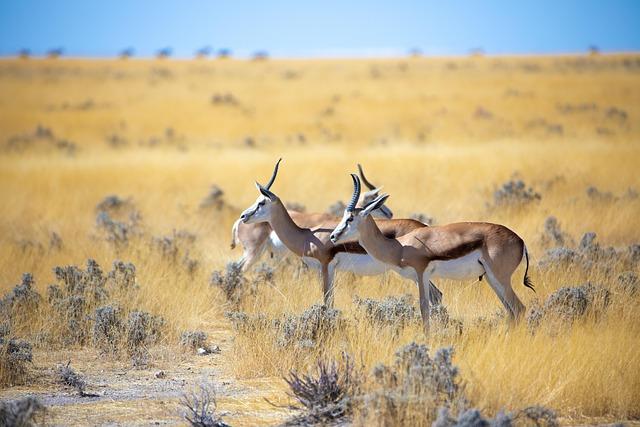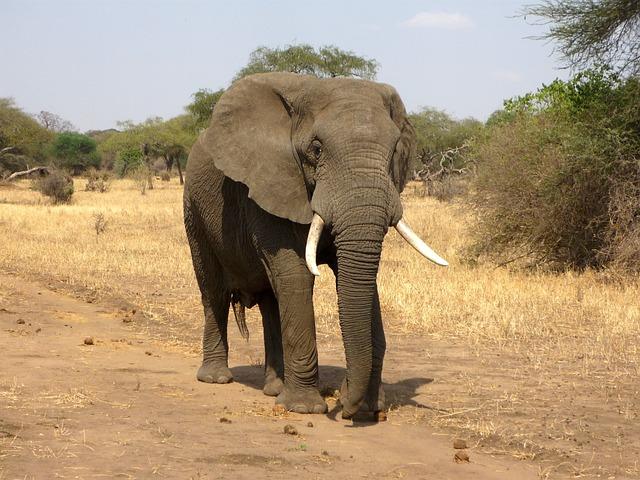Namibia is going through a debatable resolution because it prepares to cull over 700 flora and fauna animals, together with elephants and hippos, in a transfer geared toward managing ecological steadiness and addressing rising human-wildlife conflicts. The plan, which has sparked significant debate amongst conservationists, govt officers, and native communities, comes to the distribution of the beef from thes culled animals to battle meals lack of confidence and give a boost to impoverished populations. As Namibia grapples with problems comparable to declining sources and lengthening flora and fauna populations, the federal government asserts that the culling is a essential step in selling sustainable coexistence. This text delves into the complexities surrounding Namibia’s plan, exploring the ecological implications, neighborhood affect, and the wider conversations about flora and fauna control within the area.
Namibia’s Arguable Flora and fauna control Technique Underneath Debate
The new announcement from Namibia’s govt in regards to the culling of over 700 animals, together with majestic elephants and hippos, has ignited a standard debate at the ethics and effectiveness of flora and fauna control methods within the nation. Proponents argue that the culling is essential to keep watch over the inhabitants of those species, which will purpose important harm to plants and pose threats to native communities. They emphasize that this motion is a part of a broader flora and fauna conservation plan, aiming to steadiness human-animal conflicts and make sure sustainable environments. Others, then again, view the measures as draconian and misaligned with conservation efforts, saying that non-lethal strategies will have to be prioritized to control flora and fauna populations.
Critics query the verdict to distribute the beef from the culled animals, arguing that it feeds right into a troubling narrative about commodifying flora and fauna for momentary positive factors. Key issues of rivalry come with:
- Issues over the moral implications of killing endangered species.
- Questions concerning the long-term sustainability of such control practices.
- Requires selection answers specializing in habitat conservation and neighborhood engagement.
As a part of this ongoing conversation, the government faces immense pressure to justify its movements to each nationwide and world audiences, which highlights the complicated interaction between native livelihood wishes and international conservation requirements.
| Arguments For Culling | Arguments In opposition to Culling |
|---|---|
| Keep an eye on overpopulation to mitigate human-wildlife war | Moral considerations referring to species extinction |
| Coverage of agricultural lands | Promotion of non-lethal inhabitants control ways |
| Doable meat distribution to native communities | Chance of undermining conservation ethics |

Ecological Affects of Culling Elephants and Hippos in Namibia
The culling of elephants and hippos in Namibia raises important ecological considerations that stretch past the fast act of looking. Those species play a very important function in keeping up the steadiness in their ecosystems. By way of at once affecting plants patterns and facilitating nutrient biking, they give a contribution to the well being in their habitats. Elephants, as a notable instance, are continuously sufficient known as “ecosystem engineers.” Their foraging conduct can form landscapes by means of developing clearings that advertise enlargement of numerous plant species. Conversely, their elimination can result in an overabundance of explicit flowers, which might regulate the habitat and negatively affect different flora and fauna depending on a balanced ecosystem.
Additionally, culling those keystone species can cause a cascade of results all over the meals internet. The prospective penalties come with:
- Disruption of predator-prey dynamics: With fewer hippos and elephants, predators might fight to search out enough meals resources, resulting in inhabitants declines.
- Soil degradation: The lack of those huge animals can impact soil well being because of decreased herbal tilling and nutrient redistribution.
- Have an effect on on water sources: Each hippos and elephants play the most important roles in managing water resources via their behaviors and habitat use.
To offer a clearer image of the prospective ecological affects, the next desk highlights the important thing roles of elephants and hippos inside their ecosystems:
| Species | Ecological Function | Doable Have an effect on of Culling |
|---|---|---|
| Elephant | Ecosystem engineer, seed disperser | Altered plants, decreased biodiversity |
| Hippo | Nutrient recycling, habitat author | Worsened water high quality, habitat loss for aquatic species |

The initiative to distribute the beef from the culled animals is a multifaceted way that seeks to have interaction native communities in managing flora and fauna populations whilst addressing meals safety. Systems are designed to contain citizens in decision-making and implementation processes, making sure that the desires and considerations of the neighborhood are prioritized. Key facets come with:
- Group Engagement: Native stakeholders are inspired to take part actively in conferences and discussions, providing their insights and shaping how this system unfolds.
- Coaching Systems: Tutorial projects supply neighborhood contributors with talents in meat processing, making sure they may be able to take care of the distribution successfully and safely.
- Useful resource Allocation: A portion of the beef from the culled animals is allotted to underprivileged households, serving to to relieve starvation in inclined populations.
Moreover, by means of involving native communities, the initiative objectives to foster a way of possession and accountability against flora and fauna conservation. The distribution is not going to handiest serve fast dietary wishes however could also be structured to cultivate long-term relationships between citizens and flora and fauna government. The result is was hoping to reduce human-wildlife conflict and advertise sustainable coexistence. under is a table illustrating key aspects of the beef distribution initiative:
| Side | Description |
|---|---|
| meat Allocation | distribution of meat to native households, specializing in the underserved |
| Coaching | workshops on meat dealing with, processing, and protection |
| Group Conferences | Common consultations to assemble comments and percentage updates |

Balancing Conservation Efforts with Human-Flora and fauna War
The verdict to cull over 700 animals, together with iconic species like elephants and hippos, raises complicated moral and ecological questions. This drastic measure, essentially geared toward mitigating human-wildlife war, displays the stark fact of conservation control in Namibia, the place rising human populations an increasing number of encroach upon flora and fauna habitats. Native communities regularly endure important losses in agriculture and belongings because of flora and fauna interactions, resulting in a urgent want for sustainable answers that prioritize each human protection and animal welfare.The problem lies to find a steadiness that minimizes war whilst maintaining biodiversity.
Efficient methods will have to combine more than a few approaches, together with:
- Group Engagement: Involving native communities in conservation efforts can foster a way of stewardship over flora and fauna.
- Non-lethal Control: Ways comparable to flora and fauna corridors,repayment schemes,and deterrence strategies can mitigate war with out resorting to culling.
- Training and Consciousness: Elevating consciousness concerning the significance of flora and fauna and biodiversity is helping construct tolerance and working out amongst peopel.
moreover, the distribution of meat from culled animals gifts an prospect to give a boost to native communities economically, probably remodeling a contentious factor right into a mutually really useful association. then again, for those projects to be triumphant, ongoing dialogues between conservationists, governments, and native populations are the most important. Enforcing a framework that respects each human livelihoods and flora and fauna conservation will probably be crucial as Namibia navigates this complicated panorama.

choices to Culling: Exploring Non-lethal Answers
as Namibia faces a contentious resolution in regards to the culling of over 700 animals, exploring non-lethal choices turns into an increasing number of pressing. More than a few methods will also be carried out to control flora and fauna populations and scale back human-wildlife war with out resorting to deadly measures. A few of these choices come with:
- relocation: Translocating animals to much less populated spaces can assist steadiness ecosystems and reduce problems with human settlements.
- Habitat amendment: Adjusting land use and making improvements to agricultural practices can create a extra harmonious coexistence between people and flora and fauna.
- Fencing and obstacles: Putting in protecting obstacles can save you flora and fauna from coming into farming spaces, thereby decreasing the possibility of war.
- Group engagement: Involving native communities in flora and fauna control can create stewardship and advertise conservation efforts, resulting in collaborative answers.
- Non-lethal deterrents: Using strategies comparable to noise repellents or chemical repellents can unquestionably assist to stay flora and fauna clear of populated spaces.
Additionally, imposing efficient flora and fauna control insurance policies that come with training and consciousness methods is important. Those projects can tell communities about flora and fauna habits and inspire coexistence. Attention of financial incentives,comparable to ecotourism,coudl additionally give a contribution definitely,developing monetary motivations to offer protection to flora and fauna fairly than cull them. The next desk outlines the prospective advantages of non-lethal answers:
| Non-lethal Answer | Doable Advantages |
|---|---|
| Relocation | Reduces native inhabitants density, selling ecosystem steadiness. |
| Habitat Amendment | Complements coexistence and minimizes human-animal war. |
| Group Engagement | Strengthens conservation dedication amongst native populations. |
| Non-lethal Deterrents | Prevents flora and fauna incursions with out harming animals. |

Global Reaction and Moral Concerns on Flora and fauna Control
The world neighborhood has expressed a mixture of worry and give a boost to referring to Namibia’s debatable resolution to kill over 700 animals, together with elephants and hippos. Critics argue that this way raises important moral questions concerning the remedy of flora and fauna and the sustainability of such practices. Conservationists emphasize the will for accountable flora and fauna control that prioritizes ecological steadiness and animal welfare. Against this, proponents of the culling protect it as a essential measure to keep watch over overpopulation and mitigate human-wildlife war, mentioning demanding situations comparable to agricultural harm and protection threats posed by means of huge herbivores.
Moreover, moral issues prolong past animal welfare to the touch on human rights and neighborhood involvement in those selections. An efficient flora and fauna control technique regularly calls for a multi-faceted way that respects the desires and voices of native communities. Key facets come with:
- Equitable distribution of sources
- Engagement with indigenous populations
- Building of different source of revenue resources derived from conservation
A complete working out of the socio-economic context is very important for crafting insurance policies that no longer handiest arrange flora and fauna but additionally give a boost to neighborhood livelihoods. The potential of distributing the beef from culled animals has sparked discussions about meals safety and native governance, making it transparent that flora and fauna control isn’t simply an ecological factor however a posh tapestry of social, financial, and moral implications.

Concluding Remarks
Namibia’s debatable resolution to cull over 700 animals, together with iconic species comparable to elephants and hippos, underscores the complicated demanding situations going through flora and fauna control within the area. The federal government’s plan objectives to deal with problems stemming from human-wildlife war, useful resource shortage, and the preservation of native ecosystems, whilst additionally offering meat for communities in want.On the other hand,this daring transfer has sparked a heated debate about moral flora and fauna conservation practices,biodiversity,and the long-term implications for Namibia’s wealthy herbal heritage. As stakeholders—together with conservationists, native communities, and policymakers—navigate this multifaceted factor, the global community watches closely, highlighting the sophisticated steadiness between human pursuits and flora and fauna preservation in an ever-changing global.
Source link : https://afric.news/2025/02/25/namibia-plans-to-kill-more-than-700-animals-including-elephants-and-hippos-and-distribute-the-meat-cnn/
Creator : Ethan Riley
Put up date : 2025-02-25 13:59:00
Copyright for syndicated content material belongs to the connected Source.



